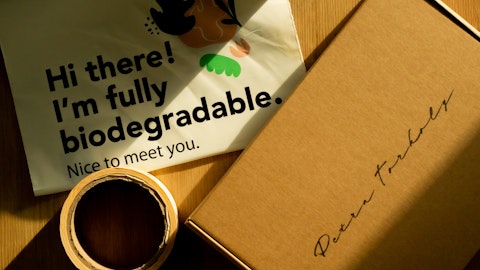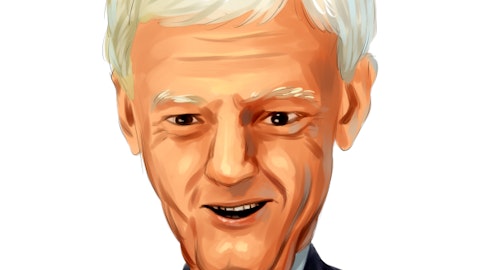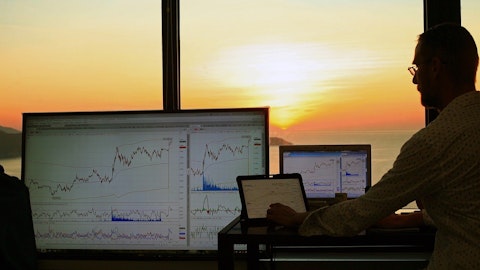George Staphos: Howard, we appreciate that. My last quick one is a great segue to that. Within industrial, within paperboard, you talked about the change in the contracts to commercial excellence and productivity. Can you give us some guardrails, i.e. if prices drop in the published indices by X or OCC goes up by Y, what that might mean to the business on a going forward basis, so that we also are managing our forecasts with less volatility or more accuracy? Thanks, and I’ll turn it over.
Howard Coker: Yes, thanks George. What I would say is we have assumed that price is going to moderate by X and cost is going to go up by Y, and that’s built into what we feel like is going to happen this year. That’s probably the best I can do, but that’s a good question, I get it. I want folks to understand that we feel like there’s going to be some moderate pressure on price and there’s going to be–OCC cannot stay at 35, so we’ve built an upward look and plan for that in our go-forward models.
George Staphos: All right, I’ll turn it over to the other folks. Thanks.
Operator: Thank you. Our next question comes from the line of Cleve Rueckert with UBS. Your line is now open.
Cleve Rueckert: Hey, good morning. Thanks for taking our questions. I wanted to follow up on the industrial business while we’re talking about. I’m just curious how much visibility you have into the industrial backlog, and just given what you know about it right now, whether there is the potential for any volume growth in 2023 or if you have visibility on a longer term basis. Then Howard, you just sort of mentioned, what are the puts and takes–you know, I know there’s some transition going on in that business, but if you could give us some help on what you’re seeing for volume growth overall in the plan, that’d be helpful.
Rodger Fuller: Yes, on the backlog question – this is Rodger – industrially, if you look at the fourth quarter, our capacity utilization across our paper business was in line with the published numbers of the industry, and as I said in my opening comments, we did take some lack of business downtime in our global paper system, more in Asia and Europe than in the U.S., and some maintenance downtime to match market demand, and we’re seeing that continue at about the same levels in January. As far as we can see, we think we’ve reached the bottom there and we’re starting to see some slight change to that in the right direction, but again, in our guidance we’re projecting year-over-year down a couple percentage points for industrial, based on what we saw.
If you remember, our first two quarters of 2022 were down around 2% year-over-year, so the real deceleration happened in the second half of the year. We expect it to turn the other way. Our toughest volume quarter should be the first quarter, and then we expect some recovery.
Howard Coker: Yes, I think what we’re seeing around the world, it looks like we’re bouncing around at bottom, at least first part of January, so expecting to see a bit of a turn. Cleve, can you explain deeper of what you mean by transition beyond what I shared earlier? I don’t want to repeat what I’d shared under George.
Cleve Rueckert: I’m just wondering how much headwind you have coming out of container board and whether there’s some other businesses that are growing. I’m just wondering what that balance is, but if you can’t share anymore, that’s fine.
Rob Dillard: Yes, that’s a good question, Cleve. We definitely look at all the various end markets, and we do sell into a number of end markets and a number of kind of final end markets, and we’ve done a really deep analysis on where did that URB or the product that’s made or facilitated by that URB product ends up going, and it’s a lot more–I’d say that those are much more consumer and stable end markets that you would anticipate with things like container board or tissue and towel in there in a meaningful way, and that’s been a part of our strategy, is to manage the mix, and one reason why we bought RTS, or are in the process of buying RTS, and one reason why we like Skjern, is because it gives us access to really utilizing the utility and the sustainability profile of URB in new markets that we think have some final growth and long term opportunity.
Howard Coker: Cleve, you know, that’s one of the things that the team is working on now. We keep talking industrial, and it gets the connotations it’s pure industrial. When you really get into it, there’s a huge consumer connection, and roughly 30%– I think I’m saying this correctly, 30% of our URB ends up in the trade sale tissue and towel sector. You wouldn’t define that as industrial, so we owe it to you guys, and I know Lisa and the team are working on helping you guys better understand the true nature of cyclicality that would tie to an industrial type slowdown.
Cleve Rueckert: That makes a lot of sense. That’s very helpful. So it sounds like maybe more stable–you’re driving towards that stable, less volatile run rate as we move through–
Howard Coker: That’s the strategic direction that we are continuing to focus on, yes.
Cleve Rueckert: Okay. Then I’m sorry if I missed it earlier, but I just–you know, just sort of recapping at a higher level on the guidance, you’ve talked about, I guess, in two of the three segments, you’ve got up–flat to up volumes, it sounds like price cost is expected to be positive pretty broadly. But you know, ultimately margins and earnings are falling a little bit year-over-year, so I’m just wondering if you could lay out at a high level what the negatives or what the headwinds are. I don’t want to belabor the negative aspects of the guidance, but just so we know what the puts and takes are.





